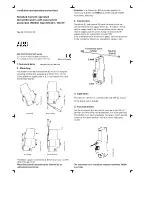
magnet, a disc held by the magnet, a rod acted on by a
spring, a lever for tripping the breaker, and a lever for me-
chanically resetting the actuator. The trip unit’s tripping pulse
counteracts the effect of the permanent magnet, allowing
the spring to separate the disc from the magnet pole piece,
while moving the rod to actuate the trip shaft lever. The de-
vice is reset when the breaker opens, since the reset lever
causes the disc to contact the magnet. If the disc is not fully
reset, the trip shaft lever will hold the breaker mechanism in
the trip-free condition, and the breaker cannot be reclosed.
3-8 Operating Mechanism
The operating mechanism is of the spring charged stored
energy type. It consists of two major parts:
1.
Stored energy or spring-charging mechanism
2.
Mechanism for closing and opening breaker
The basic parts of these mechanisms are combined into one
sub-assembly. Two varieties of the mechanism, manual and
power operated spring charge, cover the entire line of DSII
and DSLII circuit breakers (Figures 3-12 and 3-13).
3-8.1 Manually Operated Circuit Breaker
On manually operated circuit breakers, the closing springs
can be charged only by hand. This is accomplished through
the use of a front mounted spring-charge handle. The spring
charge handle used with manually operated circuit breakers
is significantly longer than the handle used with power oper-
ated circuit breakers. Actual closing of the breaker is done
only by pushing on the front control panel close bar (Figure
3-3). An optional electrical spring release, normally supplied
only on power operated circuit breakers, can be supplied on
the manually operated version.
The breaker can be tripped open manually by pushing the
trip plate on the front control panel. Tripping will also occur
if the trip plate on the circuit breaker compartment door is
pushed while the breaker is in the CONNECT position.
Electrical tripping of a manually operated circuit breaker can
take place through the following devices:
•
Optional shunt trip device
•
Trip actuator energized from the electronic trip unit
•
Optional undervoltage trip device
•
Blown limiter indicator on DSLII type breakers
Anti-Bounce
Latch
Mechanism
Frame
Manual Charge
Cam
R.H. Close
Spring
R.H. Spring
Crank Arm
Main Drive
Link
Open & Close
Indicator
Trip Latch
Reset Spring
Roller
Constraining
Link
FRONT
REAR
(Close Springs Removed)
Figure 3-12 Typical Front/Rear Views of Manual Spring Charge Mechanism
Effective July 2010
Instructional Book
IB694C694-03
23
eaton corporation
www.eaton.com






































